
- •Study Skills Workshop
- •1.1 An Introduction to the Whole Numbers
- •1.2 Adding Whole Numbers
- •1.3 Subtracting Whole Numbers
- •1.4 Multiplying Whole Numbers
- •1.5 Dividing Whole Numbers
- •1.6 Problem Solving
- •1.7 Prime Factors and Exponents
- •1.8 The Least Common Multiple and the Greatest Common Factor
- •1.9 Order of Operations
- •THINK IT THROUGH Education Pays
- •2.1 An Introduction to the Integers
- •THINK IT THROUGH Credit Card Debt
- •2.2 Adding Integers
- •THINK IT THROUGH Cash Flow
- •2.3 Subtracting Integers
- •2.4 Multiplying Integers
- •2.5 Dividing Integers
- •2.6 Order of Operations and Estimation
- •Cumulative Review
- •3.1 An Introduction to Fractions
- •3.2 Multiplying Fractions
- •3.3 Dividing Fractions
- •3.4 Adding and Subtracting Fractions
- •THINK IT THROUGH Budgets
- •3.5 Multiplying and Dividing Mixed Numbers
- •3.6 Adding and Subtracting Mixed Numbers
- •THINK IT THROUGH
- •3.7 Order of Operations and Complex Fractions
- •Cumulative Review
- •4.1 An Introduction to Decimals
- •4.2 Adding and Subtracting Decimals
- •4.3 Multiplying Decimals
- •THINK IT THROUGH Overtime
- •4.4 Dividing Decimals
- •THINK IT THROUGH GPA
- •4.5 Fractions and Decimals
- •4.6 Square Roots
- •Cumulative Review
- •5.1 Ratios
- •5.2 Proportions
- •5.3 American Units of Measurement
- •5.4 Metric Units of Measurement
- •5.5 Converting between American and Metric Units
- •Cumulative Review
- •6.2 Solving Percent Problems Using Percent Equations and Proportions
- •6.3 Applications of Percent
- •6.4 Estimation with Percent
- •6.5 Interest
- •Cumulative Review
- •7.1 Reading Graphs and Tables
- •THINK IT THROUGH The Value of an Education
- •Cumulative Review
- •8.1 The Language of Algebra
- •8.2 Simplifying Algebraic Expressions
- •8.3 Solving Equations Using Properties of Equality
- •8.4 More about Solving Equations
- •8.5 Using Equations to Solve Application Problems
- •8.6 Multiplication Rules for Exponents
- •Cumulative Review
- •9.1 Basic Geometric Figures; Angles
- •9.2 Parallel and Perpendicular Lines
- •9.3 Triangles
- •9.4 The Pythagorean Theorem
- •9.5 Congruent Triangles and Similar Triangles
- •9.6 Quadrilaterals and Other Polygons
- •9.7 Perimeters and Areas of Polygons
- •THINK IT THROUGH Dorm Rooms
- •9.8 Circles
- •9.9 Volume
- •Cumulative Review
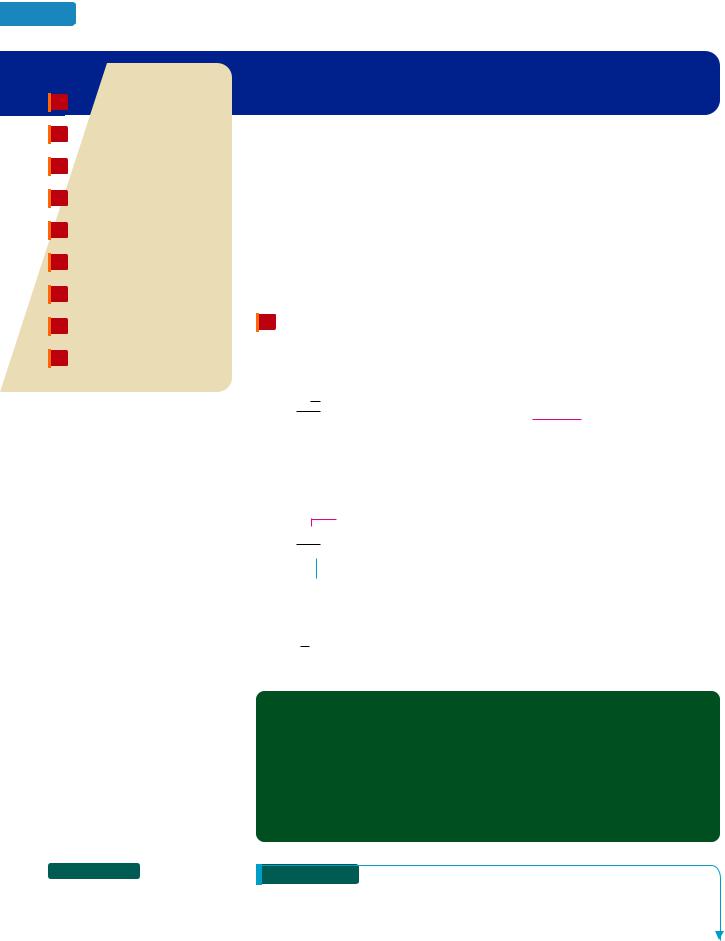
358 Chapter 4 Decimals
Objectives |
S E C T I O N 4.4 |
1Divide a decimal by a whole number.
2Divide a decimal by a decimal.
3Round a decimal quotient.
4Estimate quotients of decimals.
5Divide decimals by powers of 10.
6Divide signed decimals.
7Use the order of operations rule.
8Evaluate formulas.
9Solve application problems by dividing decimals.
Dividing Decimals
In Chapter 1, we used a process called long division to divide whole numbers.
Long division form
|
|
|
2 |
|
|
|
Quotient |
|
Divisor |
|
|
5 |
10 |
|
|
|
Dividend |
|
|
|
10 |
|
|
|
|
|
|
|
|
0 |
|
|
Remainder |
||
In this section, we consider division problems in which the divisor, the dividend, or both are decimals.
1 Divide a decimal by a whole number.
To develop a rule for decimal division, let’s consider the problem 47 10. If we rewrite the division as 4710 , we can use the long division method from Chapter 3 for changing an improper fraction to a mixed number to find the answer:
4107 |
Here the result is written in quotient remainder form. |
10 47 |
divisor
40 7
To perform this same division using decimals, we write 47 as 47.0 and divide as we would divide whole numbers.
Note that the decimal point in the quotient (answer) is placed
4.7 directly above the decimal point in the dividend.
10 47.040
7 0 After subtracting 40 from 47, bring down the 0 and continue to divide.
7 0
0 The remainder is 0.
Since 4 107 4.7, either method gives the same answer. This result suggests the following method for dividing a decimal by a whole number.
 Self Check 1
Self Check 1
Divide: 20.8 4. Check the result.
Now Try Problem 15
Dividing a Decimal by a Whole Number
To divide a decimal by a whole number:
1.Write the problem in long division form and place a decimal point in the quotient (answer) directly above the decimal point in the dividend.
2.Divide as if working with whole numbers.
3.If necessary, additional zeros can be written to the right of the last digit of the dividend to continue the division.
Divide: 42.6 6. Check the result.
Strategy Since the divisor, 6, is a whole number, we will write the problem in long division form and place a decimal point directly above the decimal point in 42.6. Then we will divide as if the problem was 426 6.
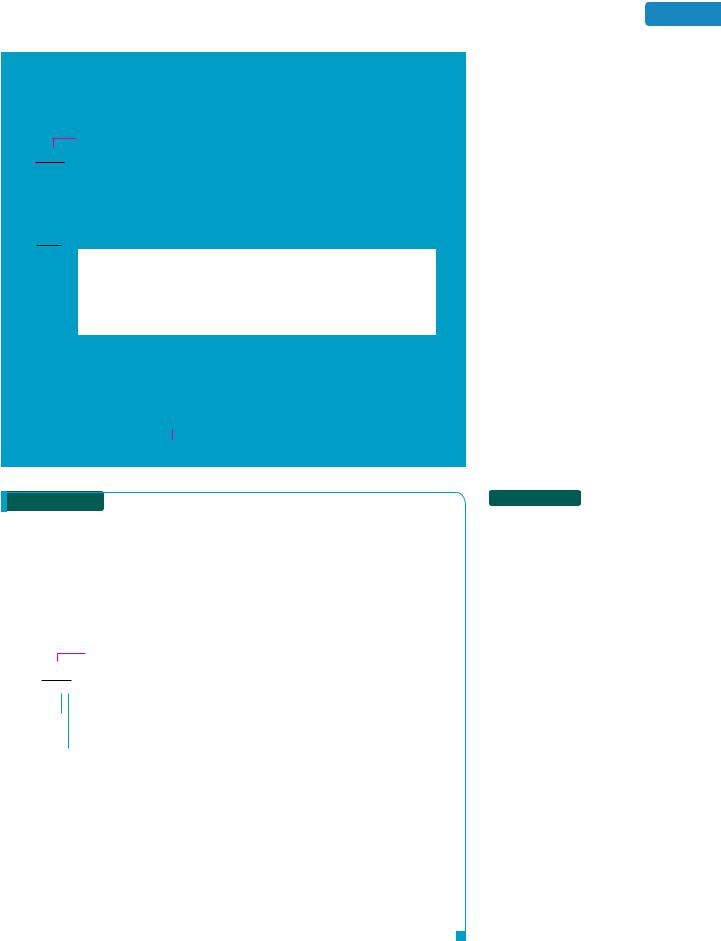
WHY To divide a decimal by a whole number, we divide as if working with whole numbers.
Solution
Step 1
Place a decimal point in the quotient that lines up
with the decimal point in the dividend.
.
6 42 . 6
Step 2 Now divide using the four-step division process: estimate, multiply, subtract, and bring down.
7.1
6 42.6 Ignore the decimal points and divide as if working with whole numbers.
42
0 6 After subtracting 42 from 42, bring down the 6 and continue to divide.
6
0 The remainder is 0.
In Section 1.5, we checked whole-number division using multiplication. Decimal division is checked in the same way: The product of the quotient and the divisor should be the dividend.
|
7.1 |
|
|
|
Quotient |
7.1 |
|||
|
6 |
|
|
|
Divisor |
6 |
42.6 |
||
|
|
|
|||||||
|
|
|
|
|
|
|
|
|
|
|
|
|
|
|
|
|
|
||
|
42.6 |
|
|
Dividend |
|
|
|
|
|
The check confirms that 42.6 6 7.1.
EXAMPLE 2 Divide: 71.68 28
Strategy Since the divisor is a whole number, 28, we will write the problem in long division form and place a decimal point directly above the decimal point in 71.68. Then we will divide as if the problem was 7,168 28.
WHY To divide a decimal by a whole number, we divide as if working with whole
numbers.
Solution
2.56
28 71.6856
15 614 0
1 681 68 0
Write the decimal point in the quotient (answer) directly above the decimal point in the dividend.
Ignore the decimal points and divide as if working with whole numbers.
After subtracting 56 from 71, bring down the 6 and continue to divide.
After subtracting 140 from 156, bring down the 8 and continue to divide.
The remainder is 0.
We can use multiplication to check this result.
2.56 |
|
|
|
|
|
28 |
2.56 |
||||
2048 |
|||||
|
|
|
|
||
28 71.68 |
|||||
5120 |
|||||
|
|||||
71.68 |
|
|
|
|
|
|
|
|
|
||
The check confirms that 71.68 28 2.56.
|
4.4 Dividing Decimals |
359 |
|
|
|
|
|
|
 Self Check 2
Self Check 2
Divide: 101.44 32
Now Try Problem 19
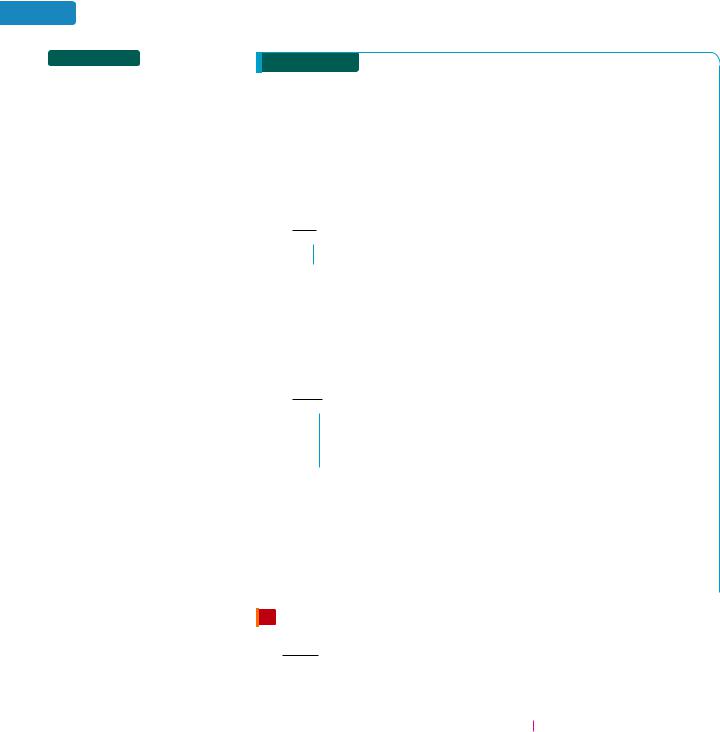
360 |
Chapter 4 Decimals |
 Self Check 3
Self Check 3
Divide: 42.8 8
Now Try Problem 23
EXAMPLE 3 Divide: 19.2 5
Strategy We will write the problem in long division form, place a decimal point directly above the decimal point in 19.2, and divide. If necessary, we will write additional zeros to the right of the 2 in 19.2.
WHY Writing additional zeros to the right of the 2 allows us to continue the division process until we obtain a remainder of 0 or the digits in the quotient repeat in a pattern.
Solution
3.8
5 19.215
4 2 After subtracting 15 from 19, bring down the 2 and continue to divide.
4 0
2 All the digits in the dividend have been used, but the remainder is not 0.
We can write a zero to the right of 2 in the dividend and continue the division process. Recall that writing additional zeros to the right of the decimal point does not change the value of the decimal. That is, 19.2 19.20.
3.84
5 19.20 Write a zero to the right of the 2 and bring it down.
15
4 2
4 0
20 Continue to divide.
20
0 The remainder is 0.
Check:
|
3.84 |
|
|
|
|
|
5 |
|
|
|
|
|
19.20 |
|
|
Since this is the dividend, the result checks. |
|
|
|
|
|||
|
|
|
|
|
|
|
|
|
|
|
|
2 Divide a decimal by a decimal.
To develop a rule for division involving a decimal divisor, let’s consider the problem
0.36 0.2592 , where the divisor is the decimal 0.36. First, we express the division in fraction form.
0.36 |
|
can be represented by |
0.2592 |
|||||
0.2592 |
||||||||
|
|
|||||||
|
|
|
|
0.36 |
||||
|
|
|
|
|
||||
|
|
|
|
Divisor |
|
|
||
|
|
|
|
|
|
|
||
|
|
|
|
|
|
|
||
To be able to use the rule for dividing decimals by a whole number discussed earlier, we need to move the decimal point in the divisor 0.36 two places to the right. This can be accomplished by multiplying it by 100. However, if the denominator of the fraction is multiplied by 100, the numerator must also be multiplied by 100 so that the fraction
maintains the same value. It follows that 100100 is the form of 1 that we should use to build
0.2592 .
0.36
0.2592 |
|
0.2592 |
|
100 |
||
0.36 |
0.36 |
|
100 |
|||
|
|
0.2592 100 |
|
|||
|
|
|
|
|
||
|
0.36 |
100 |
|
|||
|
|
25.92 |
|
|
|
|
|
36 |
|
|
|
|
|
|
|
|
|
|
|
|
Multiply by a form of 1.
Multiply the numerators.
Multiply the denominators.
Multiplying both decimals by 100 moves their decimal points two places to the right.
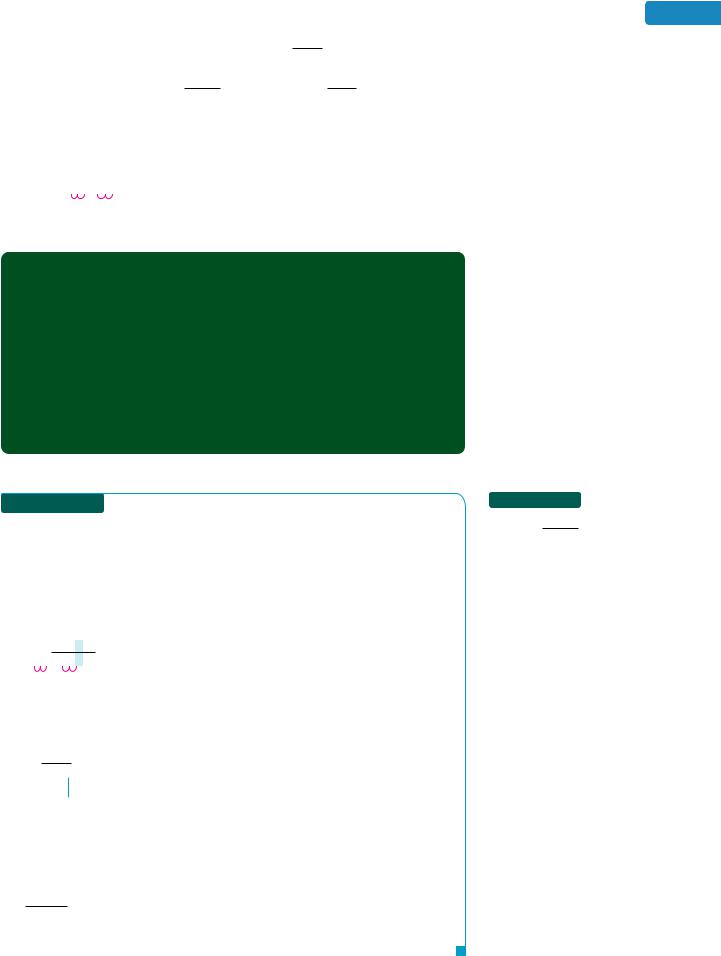
4.4 Dividing Decimals |
361 |
This fraction represents the division problem 36 25.92. From this result, we have the following observations.
•The division problem 0.36 0.2592 is equivalent to 36 25.92; that is, they have the same answer.
•The decimal points in both the divisor and the dividend of the first division problem have been moved two decimal places to the right to create the second division problem.
|
|
|
becomes |
36 |
|
25.92 |
0.36 0.2592 |
|
|||||
These observations illustrate the following rule for division with a decimal divisor.
Division with a Decimal Divisor
To divide with a decimal divisor:
1.Write the problem in long division form.
2.Move the decimal point of the divisor so that it becomes a whole number.
3.Move the decimal point of the dividend the same number of places to the right.
4.Write the decimal point in the quotient (answer) directly above the decimal point in the dividend. Divide as if working with whole numbers.
5.If necessary, additional zeros can be written to the right of the last digit of the dividend to continue the division.
|
EXAMPLE 4 |
0.2592 |
|
|
|
Divide: |
|
|
|
|
|
|
|
0.36 |
|
Strategy We will move the decimal point of the divisor, 0.36, two places to the right and we will move the decimal point of the dividend, 0.2592, the same number of places to the right.
WHY We can then use the rule for dividing a decimal by a whole number.
Solution We begin by writing the problem in long division form.
.
0 36 0 25 . 92 Move the decimal point two places to the right in the divisor and
|
|
|
the dividend. Write the decimal point in the quotient (answer) |
|
directly above the decimal point in the dividend. |
Since the divisor is now a whole number, we can use the rule for dividing a decimal by a whole number to find the quotient.
0.72
36 25.92 Now divide as with whole numbers.
25 2
72
72
0
Check:
0.7236
432
2160
 Self Check 4
Self Check 4
Divide:
0.6045
0.65
Now Try Problem 27
25.92Since this is the dividend, the result checks.
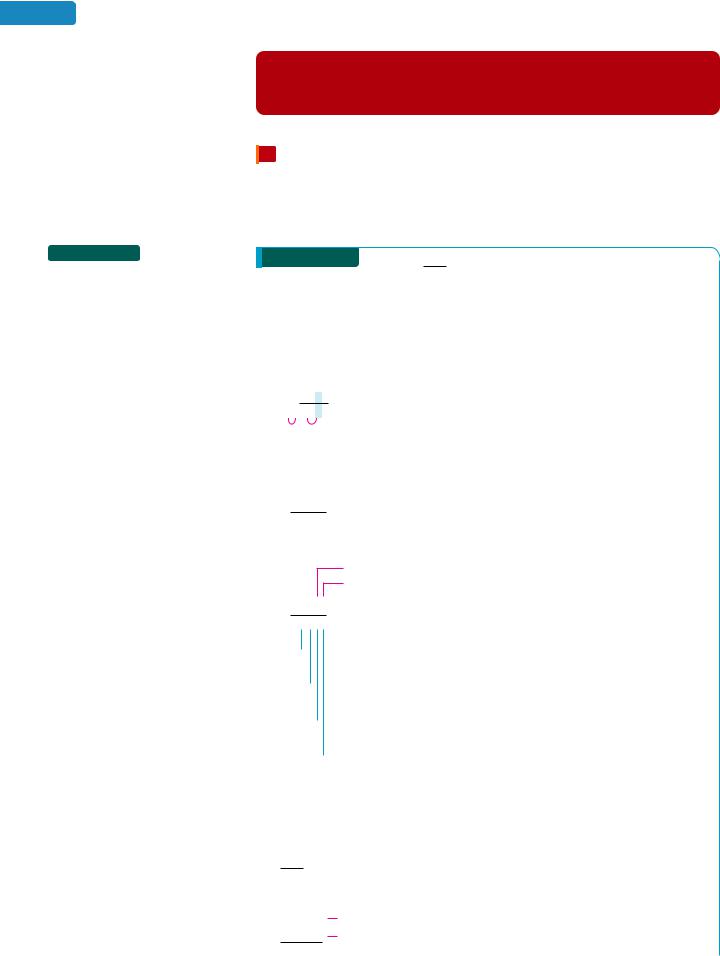
362 |
Chapter 4 Decimals |
Success Tip When dividing decimals, moving the decimal points the same number of places to the right in both the divisor and the dividend does not change the answer.
 Self Check 5
Self Check 5
Divide: 12.82 0.9. Round the quotient to the nearest hundredth.
Now Try Problem 33
3 Round a decimal quotient.
In Example 4, the division process stopped after we obtained a 0 from the second subtraction. Sometimes when we divide, the subtractions never give a zero remainder, and the division process continues forever. In such cases, we can round the result.
Divide: 9.350.7 . Round the quotient to the nearest hundredth.
Strategy We will use the methods of this section to divide to the thousandths column.
WHY To round to the hundredths column, we need to continue the division process for one more decimal place, which is the thousandths column.
We begin by writing the problem in long division form.
.
0 7 93 . 5 To write the divisor as a whole number, move the decimal point one place |
|
|
|
to the right. Do the same for the dividend. Place the decimal point in the quotient (answer) directly above the decimal point in the dividend.
2 5
2 1
4035
5049 1
Since the test digit 7 is 5 or greater, we will round 13.357 up to approximate the quotient to the nearest hundredth.
9.35
0.7 13.36 Read as “is approximately equal to.”
Check:
13.36The approximation of the quotient
0.7 The original divisor
9.352 |
|
|
Since this is close to the original dividend, 9.35, the result seems reasonable. |
|
|
|
|
|
|
|
|
|
|
|

Success Tip To round a quotient to a certain decimal place value, continue the division process one more column to its right to find the test digit.
Using Your CALCULATOR Dividing Decimals
The nucleus of a cell contains vital information about the cell in the form of DNA. The nucleus is very small: A typical animal cell has a nucleus that is only 0.00023622 inch across. How many nuclei (plural of nucleus) would have to be laid end to end to extend to a length of 1 inch?
To find how many 0.00023622-inch lengths there are in 1 inch, we must use division: 1 0.00023622.
1 |
|
.00023622 |
|
|
4233.3418 |
On some calculators, we press the ENTER key to display the quotient.
It would take approximately 4,233 nuclei laid end to end to extend to a length of 1 inch.
4 Estimate quotients of decimals.
There are many ways to make an error when dividing decimals. Estimation is a helpful tool that can be used to determine whether or not an answer seems reasonable.
To estimate quotients, we use a method that approximates both the dividend and the divisor so that they divide easily. There is one rule of thumb for this method: If possible, round both numbers up or both numbers down.
EXAMPLE 6 Estimate the quotient: 248.687 43.1
Strategy We will round the dividend and the divisor down and find 240 40.
WHY The division can be made easier if the dividend and the divisor end with zeros. Also, 40 divides 240 exactly.
Solution
|
|
The dividend is |
|
|
|
|
|||
|
|
|
|
|
|
||||
|
|
approximately |
|
|
|
|
|||
|
|
|
|
|
|
|
|
|
|
|
|
|
|
|
|
|
|
||
248.687 43.1 |
|
240 40 6 To divide, drop one zero from 240 |
|||||||
|
|
|
|
|
|
|
|
|
|
|
|
|
|
|
|
|
|
|
and from 40, and find 24 4. |
|
|
|
|
|
The divisor is |
|
|||
|
|
|
|
|
|
|
|||
|
|
|
|
|
approximately |
|
|
||
|
|
|
|
|
|
|
|||
|
|
|
|
|
|
|
|
|
|
The estimate is 6.
If we calculate 248.687 43.1, the quotient is exactly 5.77. Note that the estimate is close: It’s just 0.23 more than 5.77.
5 Divide decimals by powers of 10.
To develop a set of rules for division of decimals by a power of 10, we consider the problems 8.13 10 and 8.13 0.1.
0.813 |
|
|
81.3 |
||
10 |
8.130 |
Write a zero to the |
0 1 |
|
81.3 |
|
|
right of the 3. |
|
|
|
8 0 |
8 |
||||
|
|
|
|
||
13 |
|
|
1 |
||
10 |
|
1 |
|||
|
|
|
|
||
30 |
|
|
3 |
||
30 |
|
|
3 |
||
0 |
|
|
0 |
||
Move the decimal points in the divisor and dividend one place to the right.
4.4 Dividing Decimals |
363 |
 Self Check 6
Self Check 6
Estimate the quotient: 6,229.249 68.9
Now Try Problems 35 and 39

364 |
Chapter 4 Decimals |
 Self Check 7
Self Check 7
Find each quotient:
a. 721.3 100 1.07
b.1,000
c.19.4407 0.0001
Now Try Problems 43 and 49
 Self Check 8
Self Check 8
Divide:
a.100.624 15.2
23.9
b.0.1
Note that the quotients, 0.813 and 81.3, and the dividend, 8.13, are the same except for the location of the decimal points. The first quotient, 0.813, can be easily obtained by moving the decimal point of the dividend one place to the left.The second quotient, 81.3, is easily obtained by moving the decimal point of the dividend one place to the right. These observations illustrate the following rules for dividing a decimal by a power of 10.
Dividing a Decimal by 10, 100, 1,000, and So On
To find the quotient of a decimal and 10, 100, 1,000, and so on, move the decimal point to the left the same number of places as there are zeros in the power of 10.
Dividing a Decimal by 0.1, 0.01, 0.001, and So On
To find the quotient of a decimal and 0.1, 0.01, 0.001, and so on, move the decimal point to the right the same number of decimal places as there are in the power of 10.
|
EXAMPLE 7 |
Find each quotient: |
||
a. 16.74 10 |
b. 8.6 10,000 |
290.623 |
||
c. |
|
|||
|
||||
|
|
|
0.01 |
|
Strategy We will identify the divisor in each division. If it is a power of 10 greater than 1, we will count the number of zeros that it has. If it is a power of 10 less than 1, we will count the number of decimal places that it has.
WHY Then we will know how many places to the right or left to move the decimal point in the dividend to find the quotient.
Solution
a. 16.74 10 1.674 Since the divisor 10 has one zero, move the decimal point one
placeto the left.
b. 8.6 10,000 .00086 Since the divisor 10,000 has four zeros, move the decimal
|
|
|
|
|
|
point four places to the left. Write three placeholder zeros |
|
|
|
(shown in blue). |
|
|
|
0.00086 |
|
c. |
290.623 |
29062.3 Since the divisor 0.01 has two decimal places, move the decimal |
|
0.01 |
|||
|
|
point in 290.623 two places to the right.
6 Divide signed decimals.
The rules for dividing integers also hold for dividing signed decimals. The quotient of two decimals with like signs is positive, and the quotient of two decimals with unlike signs is negative.
|
EXAMPLE 8 |
|
|
38.677 |
|
Divide: a. 104.483 |
16.3 |
b. |
|
|
0.1 |
|||
|
|
|
|
Strategy In part a, we will use the rule for dividing signed decimals that have different (unlike) signs. In part b, we will use the rule for dividing signed decimals that have the same (like) signs.

|
|
|
4.4 Dividing Decimals |
365 |
WHY In part a, the divisor is positive and the dividend is negative. In part b, both |
Now Try Problems 51 and 55 |
|
||
the dividend and divisor are negative. |
|
|
|
|
Solution |
|
|
|
|
a. First, we find the absolute values: 0 104.483 |
0 104.483 and |
0 16.3 0 16.3. |
|
|
Then we divide the absolute values, 104.483 by 16.3, using the methods of this section.
163
|
6.41 |
|
|
|
|
|
1044.83 |
|
978 |
|
|
|
66 |
8 |
|
65 |
20 |
|
1 |
63 |
|
1 |
63 |
|
|
0 |
Move the decimal point in the divisor and the dividend one place to the right.
Write the decimal point in the quotient (answer) directly above the decimal point in the dividend.
Divide as if working with whole numbers.
Since the signs of the original dividend and divisor are unlike, we make the final answer negative. Thus,
104.483 16.3 6.41
Check the result using multiplication.
b.We can use the rule for dividing a decimal by a power of 10 to find the quotient.
38.6770.1
386.77
Since the divisor 0.1 has one decimal place, move the decimal point in 38.677 one place to the right. Since the dividend and divisor have like signs, the quotient is positive.
7 Use the order of operations rule.
Recall that the order of operations rule is used to evaluate expressions that involve more than one operation.
|
EXAMPLE 9 |
2(0.351) 0.5592 |
||
|
|
Evaluate: |
|
|
|
|
|
0.6 |
|
|
|
0.2 |
||
Strategy We will evaluate the expression above and the expression below the fraction bar separately. Then we will do the indicated division, if possible.
WHY Fraction bars are grouping symbols. They group the numerator and denominator.
Solution
2(0.351) 0.5592
0.20.6
0.702 0.55920.4
1.2612
0.4
3.153
In the numerator, do the multiplication. In the denominator, do the subtraction.
In the numerator, do the addition.
Do the division indicated by the fraction bar. The quotient of two numbers with unlike signs is negative.
|
1 |
1 |
1 |
|
0.351 |
0.7020 |
|
|
2 |
0.5592 |
|
|
0.702 |
1.2612 |
|
3.153
4 12.61212
6
4 21
20 12
12 0
 Self Check 9
Self Check 9
2.7756 3( 0.63)
Evaluate:
0.4 1.2
Now Try Problem 59

366 |
Chapter 4 Decimals |
 Self Check 10
Self Check 10
Evaluate the formula l Aw for A 5.511 and w 1.002.
Now Try Problem 63
 Self Check 11
Self Check 11
FRUIT CAKES A 9-inch-long fruitcake loaf is cut into 0.25-inch- thick slices. How many slices are there in one fruitcake?
Now Try Problem 95
8 Evaluate formulas.
|
EXAMPLE 10 Evaluate the formula b |
2A |
for A 15.36 and h 6.4. |
|
h |
||
|
|
|
Strategy In the given formula, we will replace the letter A with 15.36 and h with 6.4.
WHY Then we can use the order of operations rule to find the value of the expression on the right side of the symbol.
Solution |
|
|
1 |
1 |
|
|
|
|||||
|
|
|
|
|
||||||||
|
2A |
|
|
15.36 |
|
|
|
|||||
B |
This is the given formula. |
|
|
|
2 |
|
|
|
||||
h |
|
|
|
|
|
|
||||||
|
|
|
|
30.72 |
|
|
|
|||||
|
2(15.36) |
Replace A with 15.36 and h with 6.4. |
|
|
|
|
4.8 |
|
|
|||
6.4 |
|
64 307.2 |
|
|
||||||||
|
|
|
|
|
||||||||
|
30.72 |
|
|
|
256 |
|
|
|
||||
|
|
In the numerator, do the multiplication. |
|
|
|
|
51 2 |
|
|
|||
6.4 |
|
|
51 2 |
|
|
|||||||
4.8 |
|
|
Do the division indicated by the fraction bar. |
|
|
|
|
0 |
|
|
||
|
|
|
|
|
|
|
|
|
|
|||
|
|
|
|
|
|
|
|
|||||
9 Solve application problems by dividing decimals.
Recall that application problems that involve forming equal-sized groups can be solved by division.
|
EXAMPLE 11 |
French Bread A bread |
slicing machine cuts 25-inch-long loaves of French |
||
bread into 0.625-inch-thick slices. How many slices |
||
are there in one loaf?
Analyze
• 25-inch-long loaves of French bread are cut into slices. |
Given |
|
• |
Each slice is 0.625-inch thick. |
Given |
• |
How many slices are there in one loaf? |
Find |
Form Cutting a loaf of French bread into equally thick slices indicates division.We translate the words of the problem to numbers and symbols.
The number of |
|
the length of |
|
the thickness |
|
slices in a loaf |
is equal to |
the loaf of |
divided by |
of one slice. |
|
of French bread |
|
French bread |
|
|
|
|
|
|
|||
|
|
|
|
|
|
The number of |
|
25 |
|
0.625 |
|
slices in a loaf |
|||||
|
|
|
|
||
of French bread |
|
|
|
|
Solve When we write 25 0.625 in long division form, we see that the divisor is a decimal.
0.625 25.000 To write the divisor as a whole number, move the decimal
|
|
|
point three places to the right. To move the decimal point |
|
three places to the right in the dividend, three placeholder |
|
zeros must be inserted (shown in blue). |
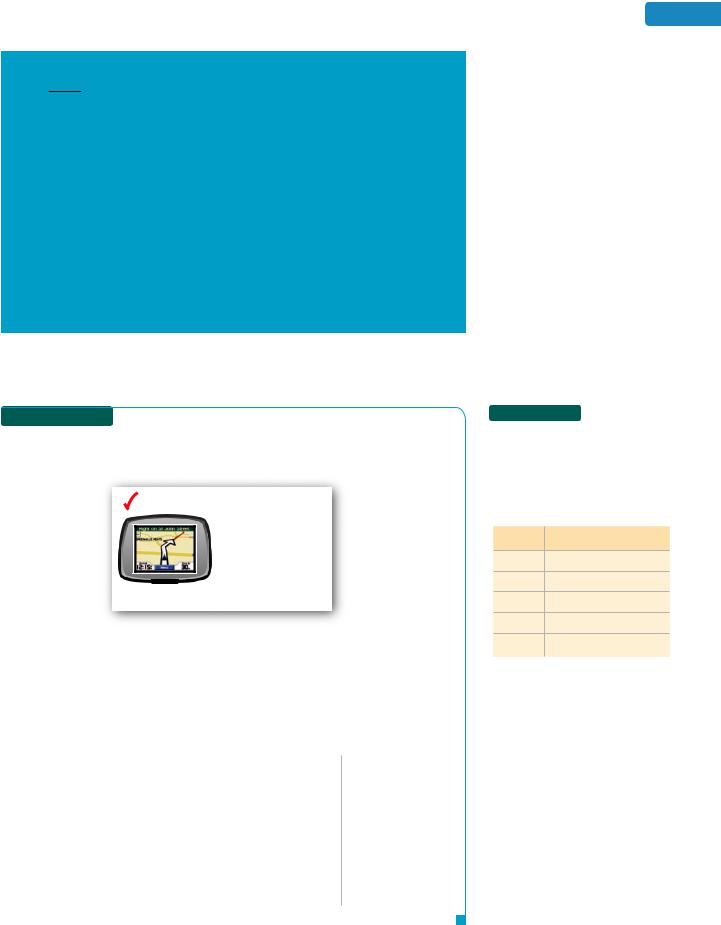
Now that the divisor is a whole number, we can perform the division.
40
625 250002500
00
0
0
State There are 40 slices in one loaf of French bread.
Check The multiplication below verifies that 40 slices, each 0.625-inch thick, makes a 25-inch-long loaf. The result checks.
|
0.625 |
|
|
The thickness of one slice of bread (in inches) |
|
|
40 |
|
|
The number of slices in one loaf |
|
|
|
|
|
|
|
|
0000 |
|
|
|
|
|
25000 |
|
|
|
|
|
25.000 |
|
|
The length of one loaf of bread (in inches) |
|
|
|
|
|||
|
|
|
|
|
|
|
|
|
|
|
|
Recall that the arithmetic mean, or average, of several numbers is a value around which the numbers are grouped. We use addition and division to find the mean (average).
 An online shopping website, Shopping.com, listed the four best prices for an automobile GPS receiver as shown below. What is the mean (average) price of the GPS?
An online shopping website, Shopping.com, listed the four best prices for an automobile GPS receiver as shown below. What is the mean (average) price of the GPS?
 Shopping.com
Shopping.com
Ebay $169.99
Amazon $182.65
Target $194.84
Overstock $204.48
200 W Car GPS Receiver
Strategy We will add 169.99, 182.65, 194.84, and 204.48 and divide the sum by 4.
WHY To find the mean (average) of a set of values, we divide the sum of the values by the number of values.
Solution
Mean |
169.99 182.65 194.84 204.48 |
Since there are 4 prices, divide the |
|
4 |
sum by 4. |
||
|
|
751.96 |
In the numerator, do the addition. |
|
4 |
|||
|
|
||
187.99 |
Do the indicated division. |
||
2 2 2 |
2 |
187.99 |
|
169.99 |
4 |
751.96 |
|
182.654
194.84 35204.48 32
751.9631
28 39
36 36
36 0
4.4 Dividing Decimals |
367 |
 Self Check 12
Self Check 12
U.S. NATIONAL PARKS Use the following data to determine the average number of visitors per year to the national parks for the years 2004 through 2008. (Source: National Park Service)
Year |
Visitors (millions) |
2008 2.749
2007 2.756
2006 2.726
2005 2.735
2004 2.769
Now Try Problem 103
The mean (average) price of the GPS receiver is $187.99.
